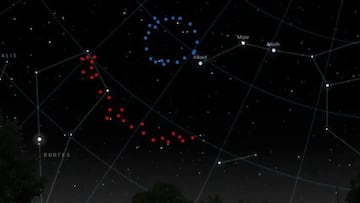Our understanding of the cosmos may change after this structure found in the depths of the universe
Astronomers have discovered another unbelievably large structure composed of galaxies and galaxy clusters in the distant universe, nicknamed the Big Ring.

Astronomers have discovered a colossal structure formed by galaxies and galaxy clusters which could challenge existing theories about the way the universe is evolving.
Alexia Lopez, a Ph.D. student at the University of Central Lancaster in the U.K., discovered the super structure in observations made by the 2.5-meter telescope of the Sloan Digital Sky Survey at Apache Point in New Mexico.
The discovery led by Lopez was presented at the 243rd meeting of the American Astronomical Society.
READ ALSO: Japan joins the elite club to pull off moon landing
The Big Ring and the Giant Arc
The group of galaxies nicknamed the “Big Ring”, measures 1.3 billion light years in diameter and four billion light years in circumference. It is the second mammoth structure discovered by Lopez. In 2021, she spotted the “Giant Arc” which had an even greater size, spanning 3.3 billion light years.
If you think this number is too huge to wrap your head around, don’t feel too bad. Even current theories of cosmology have not accounted for systems of this size.
“From current cosmological theories we didn’t think structures on this scale were possible,” said Lopez.
“We could expect maybe one exceedingly large structure in all our observable universe. Yet, the Big Ring and the Giant Arc are two huge structures and are even cosmological neighbors.”
“Neither of these two ultra-large structures is easy to explain in our current understanding of the universe,” she adds.
The Big Ring’s size exceeds supposed size limits on systems
Cosmologists had pegged the theoretical maximum size of structures in the universe at 1.2 billion light years. However, both the Big Ring and the Giant Arc have surpassed this limit. The two systems appear to be close to each other and are at the same distance from Earth. This could mean that they belong to a common cosmological system.
Because of its mind-boggling size and shape, the discovery of the Big Ring is causing scientists to look more closely at the Cosmological Principle.
READ ALSO: Boeing under fire after a series of safety failures
What is the Cosmological Principle?
This principle is a fundamental concept in cosmology, the scientific study of the origin and behavior of the universe. The principle is a guiding assumption that helps simplify and understand the overall structure and dynamics of the cosmos.
The Cosmological Principle (CP) is based on two key ideas. The first is homogeneity, which states that the universe is homogeneous and that on large scales, it appears roughly the same in all locations. The second is isotropy, which states that the isotropic universe looks the same in all directions when observed on a large scale.
The CP does not assert homogeneity and isotropy on smaller scales or in localized regions of the universe, where structures like galaxies, galaxy clusters, and cosmic voids are observed.
The Big Ring and Giant Arc are violating the Cosmological Principle by their sheer size. Their unusual shapes are also factors to consider. If Lopez and her team’s conclusions about these super structures hold true, scientists might have to consider what the implications would be on current cosmological theory.






